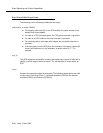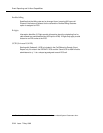
Event Reporting and U-Abort Capabilities
Issue 7 May 1998
3-23
lookahead interflow information
This includes the name of the VDN that interflowed the call, the time at which the
call entered vector processing, and the priority with which the call was queued.
If present, this information is passed unchanged to the adjunct as received by the
destination ECS. If information is not present, no information is passed.
domain
The extension of the monitored domain (ACD split/skill or VDN).
user to user information
(Contains up to 32 bytes.) If a call with UUI is delivered to a monitored domain
(ACD split or VDN), ECS includes the UUI stored with the call in the Call Offered
to Domain Event Report. This applies to UUI that originated in an ISDN PRI/BRI
SETUP message; or in an ASAI Route Select, 3rd Party Make Call, or 3rd Party
Auto-Dial.
The UUI IE sent over an ISDN trunk can contain more data than the UUI IE sent to
ASAI. This happens when the ISDN trunk group is administered with
supplementary service protocol other than B, and the UUI IE Treatment is set to
“shared”. The UUI for ASAI is packed within the shared UUI before it is sent over
an ISDN trunk, and is unpacked at the other end.
This is transparent to the ASAI adjuncts, with two exceptions:
1. If the maximum size UUI allowed on the ISDN trunk is exceeded, then the
lower priority data items will be dropped. Whether or not this means that
ASAI UUI is dropped depends on the priorities of the data items. These
priorities are administered on each trunk group form. Each item stored in
shared UUI uses 2 extra bytes.Therefore, if the ISDN trunk group is
administered to allow a shared UUI length of 32 bytes then the ASAI UUI
will be limited to 30 bytes instead of 32.
2. If a service provider, or customer equipment other than a DEFINITY ECS
(R6.3 or later) will be interpreting the contents of the UUI IE, then the trunk
group used to place those calls should have its UUI IE Treatment set to
“service-provider”. This sends the UUI as specified by the ASAI application,
without change.
For more information, see the Section, ‘‘Integrated Services Digital
Network (ISDN),’’ in Chapter 12, ‘‘ASAI and Feature Interactions.’’


















